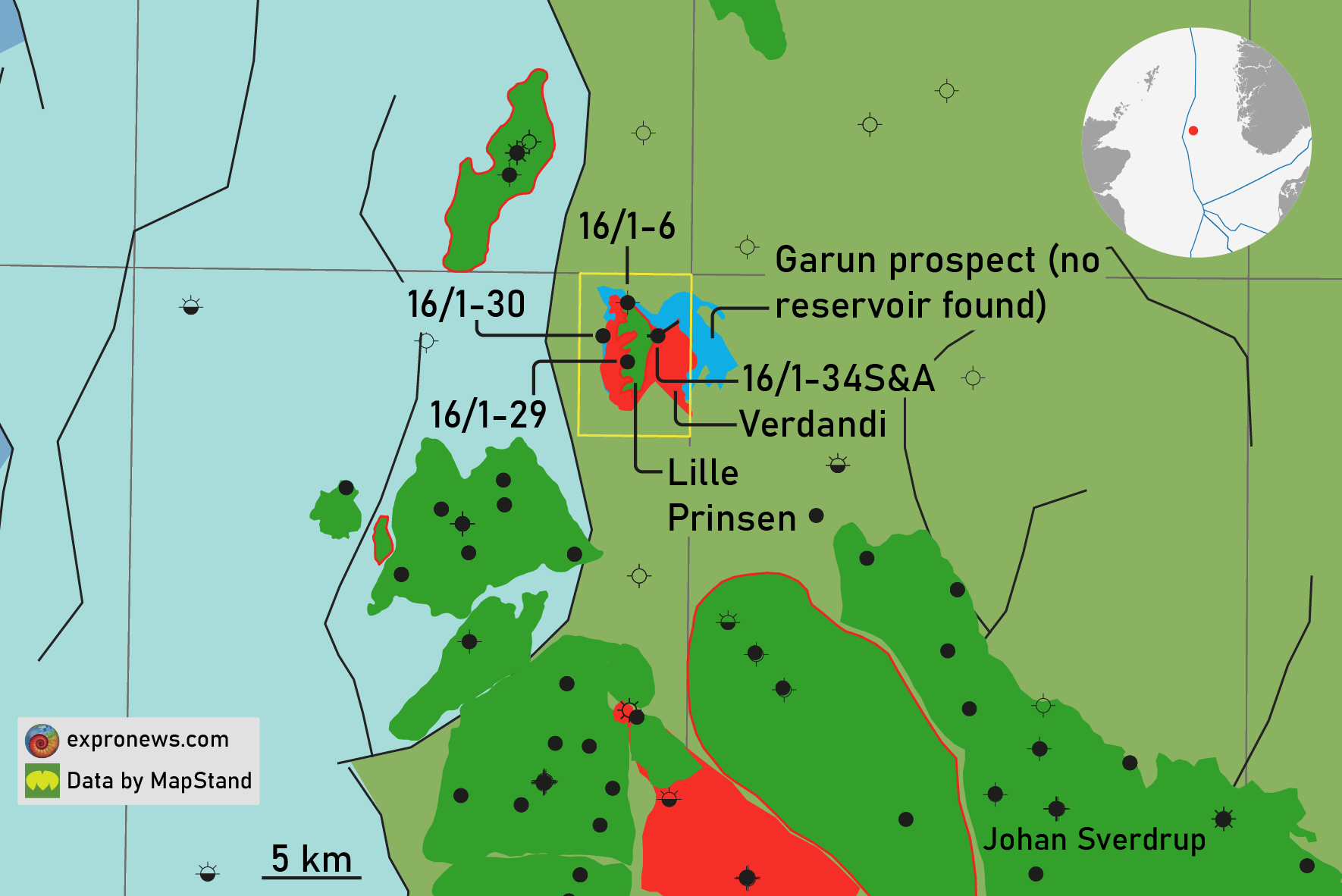Operator Lundin targeted multiple reservoirs with the now completed Lille Prinsen 16/1-34S&A drilling campaign. Before the main target – the Zechstein – was drilled by well 16/1-34A, the shallower Paleocene Heimdal sandstones of the Verdandi discovery were targeted by the S well. A 7 m thick oil-bearing sandstone was found in the Heimdal with a contact at 1820 m TVD. The overall thickness of the Paleocene sand was 50 m.
The Verdandi discovery is now estimated to host between 1.9 and 10 MMb of recoverable oil.
In well 16/1-6S, the discovery well of the Verdandi accumulation, only gas was found in the Heimdal at around 1880 m. In 16/1-29S, an oil-down to was found in the Heimdal at 1809.2 m.
Jurassic Garun prospect
The second target of the 16/1-34A well was a Jurassic sandstone interval that was thought to be prospective towards the east/northeast of Lille Prinsen (blue outline in map above). However, no reservoirs of this age were found, which may suggest that the Jurassic is only present towards the west of Lille Prinsen where 16/1-30S and A proved an up to 6.3 MMb oil accumulation in Jurassic sandstones.
Zechstein
Probably the most interesting target from a geological point of view was how the Zechstein reservoir would come in with the 16/1-34A borehole. It did prove a 66 m oil column in good quality Zechstein dolomites (46 m) and basement (20 m).
Based on these results, the total estimated size of the Lille Prinsen discovery ranges between 10 and 50 MMb of recoverable oil. The press release states that this includes the Jurassic sandstone discovery from well 16/1-30S and A, which leaves a range of 4 to 44 MMb in the Zechstein and basement of Lille Prinsen. This means that the size of the accumulation has increased, as the estimates based on drilling 16/1-29S were between 16 and 35 MMboe recoverable.
Test results useful for MNSH operators
The Zechstein reservoir of Lille Prinsen was also tested in well 16/1-34A, with a maximum production rate of 3,585 barrels of oil flow per day through a 42/64-inch nozzle opening. Given that the Zechstein is also being targeted in the area of the UK Mid North Sea High and the lithology looks similar, it is worth looking at a few production test results from similar Zechstein intervals elsewhere.
Well UK 30/16-1, the discovery well of the Auk field, found oil in a thin vuggy Zechstein dolomite section. It tested at 5,900 barrels a day at unknown surface constraints. UK well 16/29-A1 tested at 6,250 barrels of oil per day from the Zechstein in the Morag field situated beneath the Paleocene Maureen field in the UK Central North Sea. And finally, the recent Ossian well drilled by ONE-Dyas in 2019 targeting a reefal buildup in the Zechstein Hauptdolomite was tested at 3,500 barrels a day with a 79% water cut.
Although the surface constraints of the tests mentioned above are not known, with the associated difficulty of comparing these to the test results of the 16/1-34A well, it may be tentatively concluded that the volumes produced from Lille Prinsen have a similar order of magnitude as the rates observed at other Zechstein well tests in the North Sea.
Lundin now aims for the discoveries to be further matured for possible project sanction before the end of 2022.
HENK KOMBRINK





